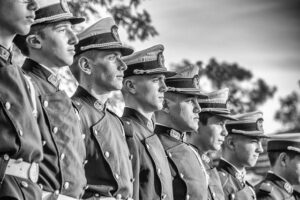
US infantry squads are still using World War I concepts and weaponry designed 40 years ago. Except for the awkward 40mm grenade launcher attachment, all firepower is based on direct fire with weak 5.56mm bullets. Furthermore, due to the world’s rapid urbanization, most combat will take place in cities, necessitating stronger weapons, especially if an opponent is wearing modern body armor.
Modern Infantry Squad Proposal
A 7.62mm medium machine gun is often used, but it is cumbersome and requires two men to operate. The use of 7.62mm light machine guns, such as a modified M-14, has been proposed, but the recoil on full automatic makes accurate fire difficult. The new MK-48 could be the answer, but this is far from certain. As a result, the SAW may continue to be the best option. The sharpshooter is more than just a sniper; he can fire through body armor, walls, doors, and automobiles. A.50 caliber rifle would be ideal, but semi-automatic models would be too heavy for an infantry squad. a bolt-action weapon. A 50-caliber rifle with five rounds is adequate for an infantry squad but not ideal.
The best sharpshooter weapon is debatable, but the 15-pound semi-automatic Barrett.338 LM (8.6mm) with a 10-round magazine is a good option. (above) Following recent interventions that revealed the need to engage enemy forces nestled among civilians in cities, the US Marine Corps may add a sharpshooter to each squad. If the.338 round enters service, it would be nice to provide an attack team member with something that can fire that round at close targets like doors, cars, and body armor—a bullpup with no scope and no bipod to make it lighter and shorter, but with the penetration power of an 8.6mm round fired through a long barrel.
Rockers
The addition of a trained rocketman, dubbed “Rocker,” at the squad level is a significant change. When two forces collide in combat, neither knows what they’ve encountered, and both sides are terrified for the first minute. If one side appears to be stronger, the other side is more likely to flee. During World War I, Erwin Rommel, an expert infantryman, wrote that the first side to set up and fire a machine gun usually won. This is why combat veterans emphasize the importance of maximum firepower on contact over well-aimed rounds.
Despite this, American infantry units rely on machine guns for platoon-level firepower and only keep a few rockets at the company level, despite the fact that most US Army platoons have a weapons squad with two rockets. As a result, when squads and even platoons come into contact, they lack powerful firepower. Firefights frequently devolve into jack-in-the-box shootouts as infantrymen exchange small arms fire for several minutes until supporting fires or heavy firepower can be brought forward. During this critical phase, wounded soldiers suffer, and the enemy has the option of maneuvering, fleeing, or advancing and overrunning the unit.
Anti-Armor Unit
The above-mentioned squad is for general-purpose missions. It should also be trained and equipped to act as an anti-armor squad when called upon. Each M-16 soldier would carry an AT-4, while the two heavy shooters with.338s would upgrade to a larger rifle. Barrett created the most popular, the M82A1 Special Applications Scoped Rifle (SASR) (pictured). This semi-automatic weapon weighs 32.5 pounds and has an effective range of 1800 meters with 10.50-caliber rounds. The SASR is lighter than an M240 7.62mm machine gun!
